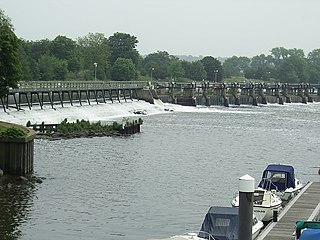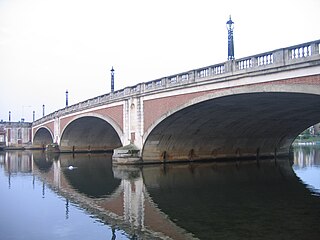
Hampton is a suburban area on the north bank of the River Thames, in the London Borough of Richmond upon Thames, England, in the historic County of Middlesex. Hampton is bounded by Bushy Park to the east, the suburbs of Hampton Hill and Fulwell to the north, green belt to the west, and the Thames to the south. Historically, the area known as Hampton included Hampton Court Palace, Hampton Hill, and Hampton Wick.

Teddington Lock is a complex of three locks and a weir on the River Thames between Ham and Teddington in the London Borough of Richmond upon Thames, England. Historically in Middlesex, it was first built in 1810.

HM Coastal Motor Boat 4 is the torpedo boat used when Lieutenant Augustus Agar earned a Victoria Cross for carrying out a raid on Soviet warships in Kronstadt and sinking the cruiser Oleg.

Molesey is a suburban district comprising two villages, East Molesey and West Molesey, in the Borough of Elmbridge, Surrey, England, and is situated on the south bank of the River Thames.

Wheatley's Ait or Wheatley Eyot is an ait (island) in the River Thames of approximately 8 hectares on the reach above Sunbury Lock, close to the northern side and in the post town Sunbury-on-Thames however in the Borough of Elmbridge in Surrey, England.

The Tideway is a part of the River Thames in England which is subject to tides. This stretch of water is downstream from Teddington Lock. The Tideway comprises the upper Thames Estuary including the Pool of London.

Hampton School Boat Club (HSBC) is the rowing club of Hampton School. Each year the club produces 1st VIIIs that compete at Championship level in the United Kingdom. The club hosts two Head race events each year.

Three river islands (aits) form a linear group, close to the junction of the two main old streets of Thames Ditton village, in the River Thames in a corner of modern Surrey, on the Kingston reach above Teddington Lock. Thames Ditton Island, the dominant ait, is 350 yards (320 m) long and has 48 houses with gardens ; Boyle Farm Island has one house; Swan Island, between the two, is the smallest.

Molesey Lock is a lock on the River Thames in England at East Molesey, Surrey on the right bank.

Sunbury Lock is a lock complex of the River Thames in England near Walton-on-Thames in north-west Surrey, the third lowest of forty four on the non-tidal reaches. The complex adjoins the right, southern bank about 1⁄2 mile (0.80 km) downstream of the Weir Hotel.

Ash Island is a forested, drop-shaped island in the River Thames in England, across the weir of Molesey Lock within Greater London on its border.

Tagg's Island, in the London Borough of Richmond upon Thames and part of Hampton, is an ait (island) on the River Thames on the reach above Molesey Lock and just above Ash Island. The island is roughly 400 metres long by 90 metres wide at its widest point, covering 6 acres. Although close to the Surrey bank near East Molesey, Surrey, the island is connected to the further Middlesex bank by a single track road bridge, being the only island on the non-tidal Thames accessible by car.

Garrick's Ait, previously known as Shank's Eyot, is an ait in the River Thames in England on the reach above Molesey Lock, the nearest land being Moulsey Hurst (park) on the Surrey bank and the opposite bank being a much narrower riverside park of Hampton. It is the only island in the United Kingdom named after an actor.

Sunbury Court Island is a long, pedestrianised residential island of houses and bungalows in the River Thames in England on the 'Sunbury and Hampton' or 'Molesey' reach, above Molesey Lock in Sunbury-on-Thames, Surrey, England.

Hampton Ferry is a seasonal foot ferry across the Thames in England. It is about 1 mile (1.6 km) upstream, west, of Hampton Court Bridge. The bridge links a busy zone of activity on both banks including Hampton Court Palace. The ferry links a large riverside park to the oldest parts of the town of Hampton, London, including its church, inn and various listed buildings such as Garrick House which is private apartments and Garrick's Temple to Shakespeare beside a narrow strip of sloped bank. This is known as Saint Albans Riverside, as it was owned by one of the Dukes of Saint Albans, seated at Hanworth House and Park, about two miles away. On the north side, this part of former Middlesex became outer-most London in 1965 by an Act of 1963. The towpath on the south side is for about 400 metres each way in public grassland with picnic places and beyond, for about 1 mile (1.6 km) shaded by trees, east and west.

Benn's Island, previously named Church Eyot, Kember's Eyot and sometimes referred to as Benn's Ait, is a private 0.1-acre (0.040 ha) ait (island) on the River Thames south-west of London. It is among a string of narrow islands above Molesey Lock and due to its clubhouse and size — the second-smallest named island on the Thames — it has deep foundation pilings to raise the building more than 1 m above the water line.
St Albans Riverside is a park in Hampton in the London Borough of Richmond upon Thames. It is linear with long sides between the Thames and Hampton Court Road. It runs from southeast of Garrick's Villa and his Temple to Shakespeare, Garrick's Lawn, Thames Street to a point 90 metres southeast of the interrupting small bridge that serves Tagg's Island.

Lady Eleanor Holles Boat Club is a rowing club on the River Thames, based at the Millennium Boat House, Lower Sunbury Road, Hampton, London. The club belongs to Lady Eleanor Holles School.





















